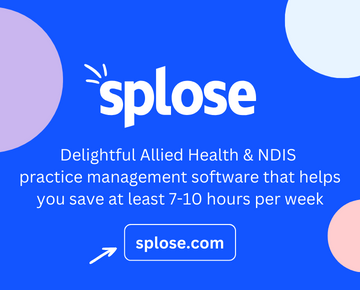Supporting Students Delivering Telehealth Services on Placement During COVID-19
The sudden transition for many allied health professions to using telehealth in practice due to COVID-19 restrictions had many professional practice educators seeking guidance as to how to sustain student clinical placements in these times.
The impact of the COVID-19 pandemic on higher education has been far reaching, particularly for programs requiring placement experiences such as occupational therapy. Across Australia there are 22 universities offering occupational therapy programs. OT students undertake a variety of professional practice experiences across the year, however many of their long block placements usually start in February.
When the COVID-19 pandemic started to escalate throughout Australia in March, the significant restrictions placed on our personal and professional way of life took many service providers by surprise and created a significant challenge in determining how their occupational therapy service may continue with these restrictions in place. Preparations and planning were quickly implemented with many agencies suddenly transitioning to alternative working arrangements, implementing working from home models, deliver services purely via telehealth, and staff being re-deployed to other priority areas. In addition to this, non-essential services were being postponed, and the social distancing requirements had a significant impact on how many staff or persons could be in attendance.
Occupational therapists quickly responded to these COVID-19 challenges and upskilled in delivering their services using telehealth, a service delivery method that up until now had been unfamiliar to most.
Clients also were abiding by these recommendations, being diligent and cautious as to what service providers they were willing to see. This often resulted in clients declining ‘non-essential’ people being present which included students.
Student Placements During COVID-19
Practice educators feel most confident in providing students with a ‘quality placement’ if they feel confident in their level of clinical knowledge, professional reasoning and experience in that area of practice, have a stable and familiar caseload, and have the time to support the students learning throughout the placement.
COVID-19 requirements had a major impact on many existing professional practice opportunities. Student placement offers were withdrawn, postponed, or needed sudden and significant adjustments. Common adjustments included: integrating more project-based learning, students ‘working from home’, or services being provided via telehealth.
As therapists adjusted their services to telehealth, the next phase was how one might successfully include students in this context. Therapists were now trying to envisage how a pure telehealth way of service delivery could provide students with enough opportunity to develop and demonstrate their occupational therapy skills effectively to achieve the required competencies. Hence many more placements were at risk of being withdrawn if a telehealth placement wasn’t a viable option for a student placement.
Supporting Placements Through Telehealth
Australian Catholic University (ACU) provides a national occupational therapy program across three campuses—Melbourne, North Sydney and Brisbane—and saw the need for specific support to practice educators as to how they could still provide a valuable student placement even if it was purely via telehealth.
An interactive webinar, designed to facilitate a sharing of experiences and ideas on how a student could demonstrate the required competencies for practice using the SPEF-R tool* was offered to our network of practice educators, student coordinators and other university placement coordinators in April 2020.
The interactive session was conducted via zoom and facilitated by the ACU professional practice team, using break out rooms to brainstorm specific examples of what is expected in a telehealth placement under each SPEF-R domain.
The session was attended by:
- Over 100 people registered to attend the sessions and/or received the follow-up resources
- People from a variety of roles including occupational therapy practice educators, agency student coordinators, managers, university placement coordinators and staff from ACU and other universities across Australia
- People joined from across the country: Victoria, New South Wales, ACT, Queensland and Western Australia. Representing metropolitan, regional and remote locations
- Working for: Government, non-government and private agencies
- Diverse areas of practice: paediatrics, adults, mental health, physical, vocational rehabilitation, hospital, community
Information from these sessions were collated into a single word document “SPEF-R examples for telehealth services” that was then shared with all registrants. In May, this was further distributed to the representatives of the Australia and New Zealand Occupational Therapy Fieldwork Association (ANZOTFA) and the Australia and New Zealand Council of Occupational Therapy Educators (ANZCOTE) for their further use and distribution.
Beyond COVID-19
We envisage that telehealth services are here to stay, and will continue to evolve and integrate into our services and student professional practice experiences. Hence this resource will be valuable to continue to supporting practice educators and occupational therapy students in developing core competencies regarding telehealth practice.
We are most grateful for our occupational therapy community who continue to support the education of our future workforce in these challenging times. We have been inspired by the flexibility, innovation, resilience and commitment to professional practice and look forward to continuing to work with you as we grow our profession.
Please contact Wendy Milgate for a copy of the word document “SPEF-R examples for telehealth services”.
About the Author
Wendy Milgate is a lecturer in occupational therapy at the Australian Catholic University—Brisbane Campus. She has been the Professional Practice Coordinator for the Bachelor of Occupational Therapy Program for the past 3 years. For a copy of the word document “SPEF-R examples for telehealth services” please contact:
Wendy Milgate
Professional Practice Coordinator (Brisbane)
Australian Catholic University
OTProfPrac.BNE@acu.edu.au
07 3861 6068
*The Student Practice Evaluation Form – Revised Edition (SPEF-R©) is an assessment tool developed at The University of Queensland and used to evaluate occupational therapy students undertaking professional practice placements across Australia. Learn more at: https://spefr.online/







.jpg)





